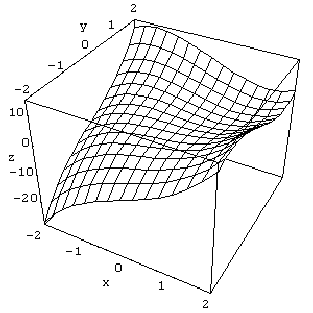Each problem is worth 10 points. Show all work for full credit.
Please circle all answers and keep your work as legible as possible. The
Independent Student Voice of the University of Oklahoma.
1. Find ![]() or show that the limit does not exist.
or show that the limit does not exist.
2. Find the directional derivative of f(x,y) = ln(x-y) at the point
(2,1) in the direction of the vector <3,-4>.
3. If we have w = f(x,y,z) where x = x(s,t,u), y = y(s,t,u), and z=z(s,t,u),
write out the appropriate chain rule for ![]() .
.
4. Find ![]() for the relation x2/3 + y2/3 + z2/3 =
1.
for the relation x2/3 + y2/3 + z2/3 =
1.
5. Moe the moose has been wandering around studying derivatives of multivariate functions. One day he was walking across the Dartmouth campus when he noticed an area shaped almost exactly like the function m(x,y) = 0.1x2+0.2y2. If Moe is standing at the point (-2,3), in which direction does the ground rise most steeply and what is that steepness?
| An actual news story appearing in The Oklahoma Daily:
Moose on campus scares Dartmouth students HANOVER, N.H. -- Amid the normal flurry of activity on the Dartmouth College Green Thursday morning, students were surprised to find a special visitor running through campus -- a moose. The moose ran through the West side of the campus Thursday morning. Although no one was hurt in the incident, there are some safety concerns when moose are running through populated areas, according to Safety and Security Officer Rebel Roberts, who responded to the call. |
6. Find all critical points of the function f(x,y) = x3 -
3xy + y3 and classify them as maxima, minima, or saddle points.
The graph provided can serve as a guide, but it's up to you to demonstrate
things.

7. Ken is a Calc IV student from California who's getting frustrated with his class. Ken says "Dude, they talk about these, like, partial everythings. It's like, they never tell you about the whole derivative. But I figure it's gotta be pretty simple, like, if you just add the partial with inspect to x and the partial with inspect to y, that must get you the total, right?"
Help Ken out by explaining (in a way he can understand!) what he's actually
getting by his method, and why it's actually better to have two partials
than one of his "totals".
8. Show that the gradient of the function f(x,y) = ln(x-y) is the same
at every point on the line y=x-2.
9. If ![]() ,
find fx(0,0).
,
find fx(0,0).
10. Show that the plane tangent to the surface f(x,y)=x2-y2
at the point (x0,y0,z0) has -z0
as its z-intercept.
Extra Credit (5 points possible):
Let B be a solid box with length L, width W, and height H. Let S be the set of all points that are a distance of at most 1 from some point of B. Express the volume of S in terms of L, W, and H.